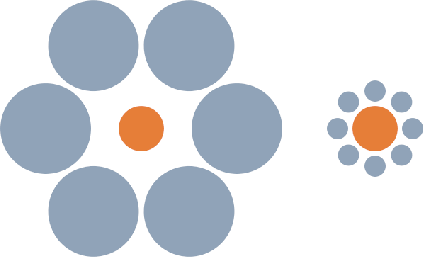
Next: Height in the visual Up: 6.1.1 Monocular depth cues Previous: 6.1.1 Monocular depth cues Contents Index
 |
Many cues result from the geometric distortions caused by perspective projection; recall the ``3D'' appearance of Figure 1.23(c). For a familiar object, such as a human, coin, or basketball, we often judge its distance by how ``large'' is appears to be. Recalling the perspective projection math from Section 3.4, the size of the image on the retina is proportional to ![]() , in which
, in which ![]() is the distance from the eye (or the common convergence point for all projection lines). See Figure 6.3. The same thing happens when taking a picture with a camera: A picture of a basketball would occupy larger part of the image, covering more pixels, as it becomes closer to the camera. This cue is called retinal image size, and was studied in [97].
is the distance from the eye (or the common convergence point for all projection lines). See Figure 6.3. The same thing happens when taking a picture with a camera: A picture of a basketball would occupy larger part of the image, covering more pixels, as it becomes closer to the camera. This cue is called retinal image size, and was studied in [97].
Two important factors exist. First, the viewer must be familiar with the object to the point of comfortably knowing its true size. For familiar objects, such as people or cars, our brains performance size constancy scaling by assuming that the distance, rather than the size, of the person is changing if they come closer. Size constancy falls of the general heading of subjective constancy, which appears through many aspects of perception, including shape, size, and color. The second factor is that, the object must be appear naturally so that it does not conflict with other depth cues.
If there is significant uncertainty about the size of an object, then knowledge of its distance should contribute to estimating its size. This falls under size perception, which is closely coupled to depth perception. Cues for each influence the other, in a way discussed in Section 6.4.
 |
One controversial theory is that our perceived visual angle differs from the actual visual angle. The visual angle is proportional to the retinal image size. This theory is used to explain the illusion that the moon appears to be larger when it is near the horizon. For another example, see Figure 6.4.
Steven M LaValle 2020-11-11